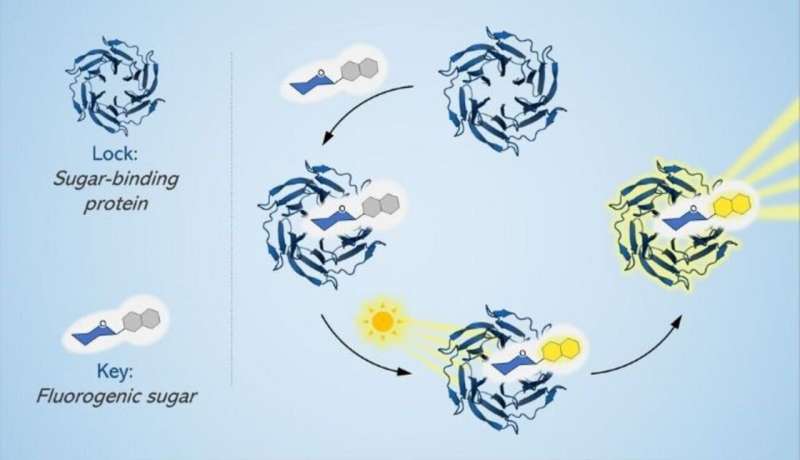This article has been reviewed according to Science X's editorial process and policies. Editors have highlighted the following attributes while ensuring the content's credibility:
fact-checked
peer-reviewed publication
trusted source
proofread
Shedding new light on sugars, the 'dark matter' of cellular biology

Scientists at Université de Montréal's Department of Chemistry have developed a new fluorogenic probe that can be used to detect and study interactions between two families of biomolecules essential to life: sugars and proteins.
The findings by professor Samy Cecioni and his students, which open the door to a wide range of applications, were published in mid-October in Angewandte Chemie International Edition.
Found in all living cells
Sugar is omnipresent in our lives, present in almost all the foods we eat. But the importance of these simple carbohydrates extends far beyond tasty desserts. Sugars are vital to virtually all biological processes in living organisms and there is a vast diversity of naturally occurring sugar molecules.
"All of the cells that make up living organisms are covered in a layer of sugar-based molecules known as glycans," said Cecioni. "Sugars are therefore on the front line of almost all physiological processes and play a fundamental role in maintaining health and preventing disease."
"For a long time," he added, "scientists believed that the complex sugars found on the surface of cells were simply decorative. But we now know that these sugars interact with many other types of molecules, in particular with lectins, a large family of proteins."
Driving disease, from flu to cancer
Like sugars, lectins are found in all living organisms. These proteins have the unique ability to recognize and temporarily attach themselves to sugars. Such interactions occur in many biological processes, such as during the immune response triggered by an infection.
Lectins are attracting a lot of attention these days. This is because scientists have discovered that the phenomenon of lectins "sticking" to sugars plays a key role in the appearance of numerous diseases.
"The more we study the interactions between sugars and lectins, the more we realize how important they are in disease processes," said Cecioni. "Studies have shown how such interactions are involved in bacteria colonizing our lungs, viruses invading our cells, even cancer cells tricking our immune system into thinking they're healthy cells."
There are still many missing pieces in the puzzle of how interactions between sugars and lectins unfold because they are so difficult to study. This is because these interactions are transient and weak, making detection a real challenge.
Two of Cecioni's students, master's candidate Cécile Bousch and Ph.D. candidate Brandon Vreulz, had the idea of using light to detect these interactions. The three researchers set to work to create a sort of chemical probe capable of "freezing" the meeting between sugar and lectin and making it visible through fluorescence.
The interaction between sugar and lectin can be described using a "lock and key" relationship, where the "key" is the sugar and the "lock" is the lectin. Chemists have already created molecules capable of blocking this lock-and-key interaction, and can now identify exactly what sugars are binding to lectins of high interest to human health.
"Our idea was to label sugar molecules with a chromophore, a chemical that gives a molecule its color," explained Cecioni. "The chromophore is actually fluorogenic, which means that it can become fluorescent if the binding of sugar with the lectin is efficiently captured. Scientists can then study the mechanisms underlying these interactions and the disturbances that can arise."
Cecioni and his students are confident their technique can be used with other types of molecules. It may even be possible to control the color of new fluorescently labeled probes that are created.
By making it possible to visualize interactions between molecules, this discovery is giving researchers a valuable new tool for studying biological interactions, many of which are critical to human health.
More information: Cécile Bousch et al, Fluorogenic Photo‐Crosslinking of Glycan‐Binding Protein Recognition Using a Fluorinated Azido‐Coumarin Fucoside, Angewandte Chemie International Edition (2023). DOI: 10.1002/anie.202314248
Journal information: Angewandte Chemie International Edition
Provided by University of Montreal





















